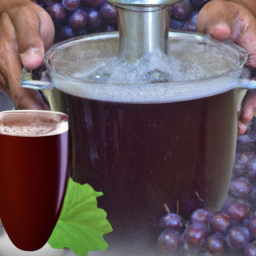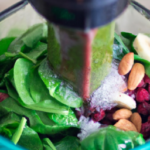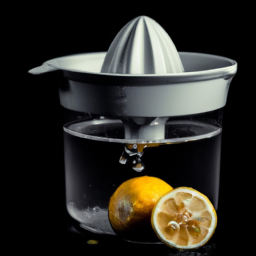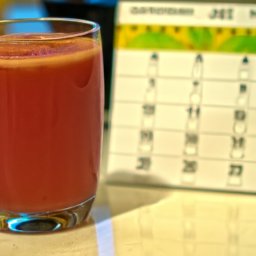The aroma of freshly brewed coffee in the morning is unmatched. Yet, if you neglect to clean your coffee maker on a regular basis, that heavenly scent can quickly turn sour.
As someone who relies on their morning cup of joe to jumpstart their day, I’ve learned firsthand the importance of keeping my coffee maker clean and free of buildup. And I’ve found that one of the best ways to do that is by using lemon juice.
Not only is lemon juice a natural cleaning agent, but it also imparts a fresh, citrusy scent to your coffee maker. Plus, it’s an affordable and easy-to-source ingredient that you likely already have on hand.
So, if you’re ready to say goodbye to stale coffee and hello to a fresh, clean brew, read on to learn how to clean your coffee maker with lemon juice.
Key Takeaways
- Lemon juice is a natural and effective way to remove mineral and coffee oil buildup in coffee makers.
- Cleaning coffee makers with lemon juice involves mixing equal parts lemon juice and water, letting it sit for 15 minutes, and rinsing thoroughly.
- Regular cleaning of coffee makers, including the filters and exterior, is important to prevent buildup and extend their lifespan.
- Lemon juice, vinegar, and baking soda are safe, non-toxic, and environmentally friendly natural cleaning solutions for coffee makers.
Why Cleaning Your Coffee Maker is Important
Don’t neglect your coffee maker’s cleanliness – it’s crucial to ensure a fresh and flavorful cup of joe every time!
One of the most important parts of cleaning your coffee maker is descaling, which is the process of removing mineral buildup from hard water. When you use hard water in your coffee maker, minerals like calcium and magnesium can build up and clog the machine, affecting the taste of the coffee and even damaging the machine over time.
Descaling your coffee maker on a regular basis can help prevent this buildup and extend the life of your machine. Using natural cleaners like lemon juice is also beneficial for cleaning your coffee maker. Not only is it effective at removing buildup and stains, but it’s also safe and eco-friendly.
Plus, the natural acidity of lemon juice can help break down any lingering oils or flavors in the machine, leaving your coffee tasting fresh and clean. Now that you understand the importance of descaling and the benefits of using natural cleaners, it’s time to gather your supplies.
Gather Your Supplies
First, let me tell you what you’ll need to clean your coffee maker with lemon juice. You’ll need a lemon, water, and a clean cloth. Make sure you have all of these supplies on hand before beginning the cleaning process.
Next, it’s important to prepare your coffee maker by emptying any leftover coffee and removing any filters or coffee grounds. This will ensure that the lemon juice can thoroughly clean the machine.
What You’ll Need
To get started with cleaning your coffee maker with lemon juice, you’ll need some basic household items. Firstly, you’ll need a fresh lemon or lemon juice concentrate. Lemon juice is an excellent natural cleaner that can remove stubborn stains and bacteria from your coffee maker. It also leaves behind a refreshing citrus scent that can help mask any unpleasant odors in your machine. If you don’t have lemons, you can use other natural alternatives such as vinegar or baking soda, but lemon juice is the most effective.
In addition to the lemon juice, you’ll need water, a clean sponge or cloth, and a measuring cup. The water is necessary to dilute the lemon juice and make it safe for use. The sponge or cloth is used to wipe the coffee maker’s exterior and interior surfaces. The measuring cup is useful in measuring the right amount of lemon juice and water to use.
Once you have all these items, you’re ready to move on to preparing your coffee maker for cleaning.
Preparing Your Coffee Maker
Before you can enjoy a fresh cup of coffee, it’s important to ensure that your trusty appliance is ready to go. Cleaning your coffee maker with lemon juice is an excellent way to get rid of any buildup and ensure that your next cup of coffee tastes as delicious as possible.
To prepare your coffee maker, you’ll need to follow these three steps:
-
Choosing the right lemon juice: When it comes to cleaning your coffee maker with lemon juice, it’s important to choose the right type of lemon juice. Freshly squeezed lemon juice is the best option, as it contains natural acids that can help break down any buildup in your coffee maker.
-
Best time to clean: You should aim to clean your coffee maker with lemon juice at least once a month. This will help to ensure that your coffee maker is always in top condition and that your coffee tastes as delicious as possible.
-
Disassembling your coffee maker: Before you can clean your coffee maker with lemon juice, you’ll need to disassemble it. This will allow you to access all of the parts that need to be cleaned, such as the carafe, filter, and brew basket.
Once your coffee maker is prepared, it’s time to create your lemon juice solution.
Create Your Lemon Juice Solution
As I begin creating my lemon juice solution, I gather a few key ingredients: lemons, water, and a measuring cup. I make sure to use fresh lemons, as they’ll provide the most effective cleaning power.
Lemon juice is not only great for cleaning, but also has alternative uses such as flavoring food and drinks, and can even be used as a natural insect repellent. It also has health benefits, such as being high in vitamin C and antioxidants.
To create the lemon juice solution, I start by cutting two lemons in half and squeezing the juice into a measuring cup. I then add water to the juice until I have a total of 2 cups of liquid. The acidity of the lemon juice will help break down any mineral buildup or stains inside my coffee maker.
With my solution ready, it’s time to move on to the next step: running my coffee maker.
Run Your Coffee Maker
Now that we’ve created our lemon juice solution, it’s time to run it through the coffee maker.
To do this, I’ll pour the solution into the water reservoir and turn on the machine as if I’m making a pot of coffee.
I’ll let the solution run through the machine completely before repeating the process for any stubborn stains.
How to Run the Lemon Juice Solution Through Your Coffee Maker
First things first, let’s brew up some lemon juice magic to get that coffee maker sparkling like new! One of the benefits of using lemon juice as a cleaning solution is that it’s a natural and inexpensive alternative to store-bought cleaners.
To make the solution, mix equal parts water and lemon juice and pour it into the coffee maker’s water reservoir. Next, run the coffee maker as you would if you were making a pot of coffee.
Allow the solution to brew and then let it sit in the carafe for about 15 minutes to give it time to work its magic. After the time has passed, pour out the solution and rinse the carafe and filter basket with clean water.
Repeat the process for stubborn stains.
Repeat the Process for Stubborn Stains
Don’t give up just yet, those pesky stains are no match for this powerful lemon juice solution! If you have stubborn stains that refuse to budge, repeat the same process of running the solution through your coffee maker, but let it sit for a longer period of time.
Instead of running the solution through once, let it cycle through your coffee maker several times. This should help to break down the buildup and remove those stubborn stains.
Alternatively, you can also use a soft-bristled brush to scrub the inside of your coffee maker, being careful not to damage any of the delicate parts. This can help to remove any remaining buildup that the lemon juice solution may have missed.
Finally, to prevent future stains, make sure to clean your coffee maker regularly and use filtered water. Now that you’ve tackled those stubborn stains, it’s time to move on to the final step – rinsing your coffee maker.
Rinse Your Coffee Maker
Now that we’ve cleaned our coffee maker with lemon juice, it’s important to thoroughly rinse it out to ensure that none of the lemon juice solution remains.
To do this, I recommend filling the coffee maker’s water reservoir with fresh water and running it through a brewing cycle without any coffee grounds.
Repeat this process a few times until you can no longer smell any traces of lemon juice.
It’s crucial to flush out the lemon juice solution completely to prevent any lingering taste or odor in your future cups of coffee.
How to Flush Out the Lemon Juice Solution
To get your coffee maker sparkling clean, you’re going to want to pour some fresh water into the reservoir and turn it on, letting the lemon juice solution flow through the machine and rinse all the residue away. Here’s how to flush out the lemon juice solution:
-
Fill the reservoir with fresh water and turn on the coffee maker. Let it run through a full cycle to flush out any remaining lemon juice and residue.
-
Repeat this process if necessary to ensure that all traces of lemon juice have been removed.
-
Once you’re satisfied that the coffee maker is clean, dry it thoroughly before using it again.
Flushing out the lemon juice solution is an essential step in the cleaning process. Failure to do so can result in a sour taste in your coffee the next time you brew. Therefore, it’s important to take the time to ensure that all traces of lemon juice have been removed before using your coffee maker again.
Importance of Thorough Rinsing
Ensuring that all traces of the cleaning solution have been thoroughly rinsed out of your machine is crucial. The importance of thorough rinsing can’t be emphasized enough, as any leftover residue can negatively impact the taste of your next cup of coffee.
It’s essential to rinse your coffee maker thoroughly with clean water after using a lemon juice solution. This will ensure that there is no leftover residue that could affect the flavor of your next brew.
The benefits of using a lemon juice cleaning solution are numerous. It’s a natural, affordable, and effective way to remove the buildup of minerals and coffee oils that can accumulate in your machine over time. However, it’s important to remember that thorough rinsing is essential to remove any traces of the cleaning solution.
With that in mind, let’s move on to the next section, where we will discuss how to clean your coffee pot.
Clean Your Coffee Pot
I always make sure to clean my coffee pot regularly to maintain its hygiene and extend its life. One of the best ways to clean a coffee pot is by using lemon juice, which is a natural and effective cleaning agent.
In this discussion, I’ll share my knowledge on how to clean a coffee pot with lemon juice, as well as tips on removing stains and mineral buildup.
How to Clean Your Coffee Pot with Lemon Juice
Using lemon juice to clean your coffee pot is one of the best cleaning alternatives available. Not only is it effective in getting rid of stubborn stains and mineral buildup, but it also has the added benefits of being a natural cleaner.
Lemon juice is acidic and contains citric acid which works effectively to dissolve mineral buildup and stains without harming the material of the coffee pot. To clean your coffee pot with lemon juice, simply mix equal parts of lemon juice and water, then pour the solution into the coffee pot and let it sit for about 15 minutes.
After that, rinse the pot thoroughly with water and dry it with a clean towel. The result is a sparkling clean coffee pot that is free of stains and mineral buildup. Now that we’ve learned how to clean your coffee pot with lemon juice, the next step is to remove any stains and mineral buildup that may be present.
This can be easily accomplished by using a solution of vinegar and water.
Removing Stains and Mineral Buildup
You may notice unsightly discoloration and hard deposits on your morning energizer, reminiscent of the buildup on a prehistoric fossil. Fear not, there are simple solutions to remove these stains and mineral buildup from your coffee maker. Here are some tips to prevent buildup and alternative cleaning methods:
-
Use filtered water: Hard water contains minerals that can cause buildup over time. Using filtered water can reduce the amount of minerals in your water and prevent buildup in your coffee maker.
-
Use vinegar: If you don’t have lemon juice on hand, vinegar can also be used to remove mineral buildup. Simply mix equal parts water and vinegar and run it through your coffee maker.
-
Use baking soda: Baking soda is a natural cleaner that can also remove mineral buildup. Mix 1/4 cup of baking soda with 1 quart of water and run it through your coffee maker.
-
Clean regularly: To prevent buildup, it’s important to clean your coffee maker regularly. This can be done by running a mixture of water and lemon juice or vinegar through your coffee maker once a month.
Preventing buildup and cleaning your coffee maker regularly can help extend its lifespan and ensure your morning cup of joe tastes just as delicious as the first time you brewed it. Now, let’s move onto the next section and learn how to clean your coffee filter.
Clean Your Coffee Filter
To effectively clean your coffee maker with lemon juice, start by cleaning your coffee filter. By doing so, you ensure that the filter is free from any debris or leftover coffee grounds that may affect the taste of your coffee. Additionally, cleaning your filter regularly will help prolong its lifespan and prevent the need for constant replacement.
There are alternative methods to cleaning your coffee filter, such as using vinegar or baking soda. However, using lemon juice has its own benefits. Not only does it effectively remove any stains and mineral buildup, but it also leaves a fresh and citrusy scent in your coffee maker. Moreover, if you use reusable filters, cleaning them regularly with lemon juice will prevent any mold or bacteria from growing. Below is a table that compares the benefits of using a reusable filter versus a paper filter.
| Benefits | Reusable Filter | Paper Filter |
|---|---|---|
| Cost | One-time purchase | Ongoing expense |
| Environmental Impact | Less waste | More waste |
| Taste | No paper taste | Possible paper taste |
| Maintenance | Requires cleaning | Disposable |
Now that you have cleaned your coffee filter, it’s time to move on to wiping down your coffee maker.
Wipe Down Your Coffee Maker
So, after cleaning the coffee filter, it’s time to focus on the exterior of the coffee maker.
I like to use lemon juice to wipe down the surface of the coffee maker, as it’s a natural disinfectant and can remove any stains or residue from the exterior.
Simply squeeze some lemon juice onto a cloth and wipe down the entire surface of the coffee maker, making sure to pay extra attention to any areas that may have buildup or stains.
How to Clean the Exterior of Your Coffee Maker with Lemon Juice
By using lemon juice, you can easily clean the exterior of your coffee maker and leave it looking sparkling clean. Lemon juice is an effective DIY cleaner that can help remove stains, grime, and hard water deposits from the exterior of your coffee maker. The benefit of natural cleaning is that it’s safe, non-toxic, and environmentally friendly.
To clean the exterior of your coffee maker with lemon juice, simply mix equal parts lemon juice and water in a spray bottle. Then, spray the mixture onto the coffee maker’s exterior and wipe it down with a soft cloth. The acid in the lemon juice helps dissolve any buildup, leaving the surface clean and shiny. Plus, the fresh scent of lemon will leave your coffee maker smelling great.
When it comes to removing stains and disinfecting surfaces, it’s important to use the right cleaning products to ensure that your coffee maker is thoroughly cleaned and free of harmful bacteria.
Removing Stains and Disinfecting Surfaces
Now that we’ve covered how to clean the exterior of your coffee maker with lemon juice, let’s move on to removing stains and disinfecting surfaces. Lemon juice is a natural and effective DIY disinfectant that can help remove hard water stains and sanitize your coffee maker. However, if you don’t have lemon juice on hand or prefer to use an alternative, there are other options available.
To remove stains and disinfect surfaces, start by filling the water reservoir with equal parts water and lemon juice. Run a brew cycle as you normally would, allowing the mixture to run through the coffee maker. Then, rinse the reservoir and run a few more cycles with plain water to ensure all the lemon juice has been flushed out.
If you don’t have lemon juice on hand, you can use white vinegar instead. Simply mix equal parts water and vinegar and run it through the coffee maker as you would with the lemon juice mixture.
Regular maintenance tips are essential to keeping your coffee maker clean and functioning properly. Let’s take a look at some simple steps you can take to keep your coffee maker in top shape.
Regular Maintenance Tips
I want to discuss some tips for regular maintenance of your coffee maker. First and foremost, it’s important to know how often to clean it. Depending on the frequency of use, it’s recommended to clean your coffee maker at least once a month. This is to prevent buildup of mineral deposits and bacteria.
There are other natural cleaning solutions that can be used besides lemon juice, such as vinegar or baking soda. These can be just as effective.
How Often to Clean Your Coffee Maker
Regularly cleaning your coffee maker is the key to keeping your coffee tasting fresh as a daisy. If you want to use lemon juice to clean your coffee maker, it’s important to know how often you should do it.
Here are a few tips to help you decide when it’s time to clean your coffee maker:
- If you use your coffee maker every day, you should clean it once a month.
- If you only use your coffee maker a few times a week, you can clean it every two months.
- If you notice that your coffee tastes bitter or has a strange odor, it’s time to clean your coffee maker.
- If you live in an area with hard water, you may need to clean your coffee maker more often.
By following these tips, you can ensure that your coffee maker stays clean and your coffee always tastes great.
If you’re interested in other natural cleaning solutions for your coffee maker, keep reading!
Other Natural Cleaning Solutions
Looking for alternative ways to keep your morning cup of joe fresh and clean? Try out some of these natural cleaning solutions for your trusty coffee brewing companion.
First off, vinegar is a great natural cleaning solution that can effectively remove mineral buildup in your coffee maker. Simply mix equal parts of white vinegar and water and let it run through your coffee maker as if you were brewing a pot of coffee. Then, rinse the coffee maker thoroughly with water to remove any residual vinegar taste.
Another natural cleaning solution to try out is baking soda. Baking soda is known for its ability to remove stains and odors, making it a perfect choice for cleaning your coffee maker. Mix a quarter cup of baking soda with a cup of warm water and pour it into the coffee maker’s water reservoir. Let it sit for about 15 minutes before running a full cycle of water through the machine. Rinse the coffee maker again with water to remove any baking soda residue.
With these natural cleaning solutions, you can easily keep your coffee maker in tip-top shape without relying on harsh chemicals. Enjoy your fresh and clean coffee!
Enjoy Your Fresh and Clean Coffee
To savor the taste of your freshly brewed coffee, take a moment to appreciate how the lemon juice has removed all the grime and buildup from your coffee maker, leaving it sparkling clean like a diamond in the sun.
Not only is lemon juice an effective cleaning solution, but it also has numerous benefits that make it a popular choice for those who prefer natural cleaning solutions. Here are a few reasons why lemon juice is a great option for cleaning your coffee maker:
- Lemon juice is a natural disinfectant that can kill bacteria and germs that may be lingering in your coffee maker.
- It’s a safe and non-toxic solution that won’t harm you or the environment.
- Lemon juice is easily accessible and affordable, making it a convenient choice for those who want to avoid harsh chemical cleaners.
- Using lemon juice can help extend the life of your coffee maker by preventing buildup and reducing the risk of clogs or malfunctions.
With your coffee maker now clean and ready for use, it’s time to enjoy your freshly brewed coffee. The taste and aroma of your coffee will be enhanced by the clean equipment, allowing you to savor every sip.
So, sit back, relax, and enjoy a cup of coffee knowing that you’ve taken steps to maintain the cleanliness and longevity of your coffee maker.
Frequently Asked Questions
Can I use other types of citrus fruit instead of lemons to clean my coffee maker?
I’ve found that alternative citrus fruits like oranges and grapefruits can be used to clean a coffee maker. However, their acidity levels may not be as effective as lemons. A comparison of effectiveness is recommended.
How often should I clean my coffee maker to ensure optimal performance?
I recommend cleaning your coffee maker every 3 months to prevent mineral buildup and bacterial growth. Signs of a dirty coffee maker include a bitter taste, slow brew time, and visible residue.
Is it safe to use lemon juice to clean a coffee maker made of plastic?
I’ve found that lemon juice is safe to use for cleaning my plastic coffee maker. It’s an effective cleaning agent that removes stubborn stains and buildup. However, always follow the manufacturer’s guidelines and rinse thoroughly to avoid any residue.
Can I add any other ingredients to the lemon juice solution to enhance the cleaning process?
I’ve found that adding a splash of vinegar to my lemon juice solution enhances its cleaning power. Lemon juice has many other uses and benefits for cleaning, and to maintain a clean coffee maker, regularly descale and clean the carafe and filter basket.
What should I do if the lemon juice solution leaves a residue or odor in my coffee maker after cleaning?
If lemon juice leaves a residue or odor in my coffee maker after cleaning, I would try alternative cleaning methods such as vinegar or baking soda. Lemon juice alternatives include citric acid or hydrogen peroxide.
Conclusion
In conclusion, cleaning your coffee maker with lemon juice is a simple and effective way to ensure your morning cup of joe is fresh and delicious. By gathering your supplies, creating the lemon juice solution, running your coffee maker, rinsing and cleaning the filter, and wiping down your machine, you can easily maintain the cleanliness of your coffee maker.
Regular maintenance, such as descaling and cleaning after each use, will keep your coffee maker in top condition for years to come. So, the next time you brew a pot of coffee, take a moment to appreciate the cleanliness of your machine and the refreshing taste of lemon in your cup.
As the old saying goes, "cleanliness is next to godliness,"and with a clean coffee maker, you’ll feel like a coffee deity.
Ilana has been a vegan for over 10 years. She originally made the switch for health reasons, but soon found herself becoming more and more passionate about the ethical and environmental implications of a vegan lifestyle. Ilana is the author of The Graceful Kitchen, a blog all about veganism. She loves to cook up delicious and nutritious vegan meals, and share her recipes with others who are interested in leading a cruelty-free life. Ilana is also a strong advocate for using whole foods as the foundation of a healthy diet, and believes that going vegan is one of the best ways to achieve this.
















